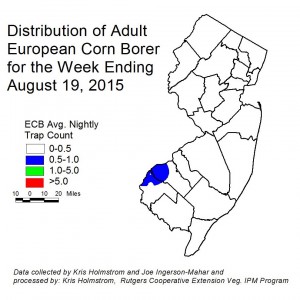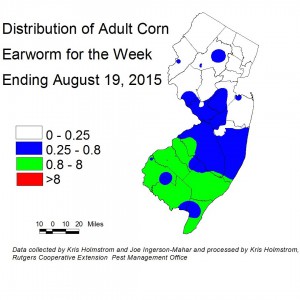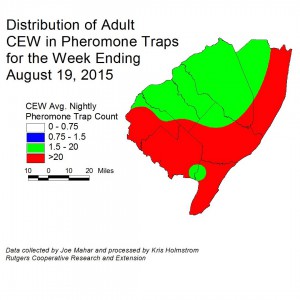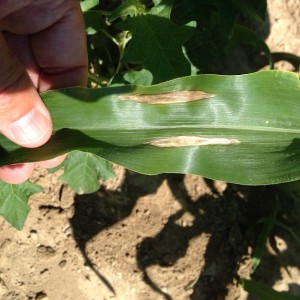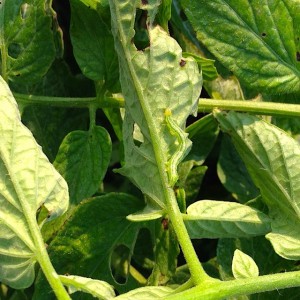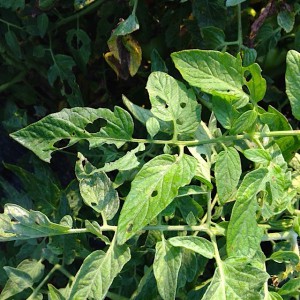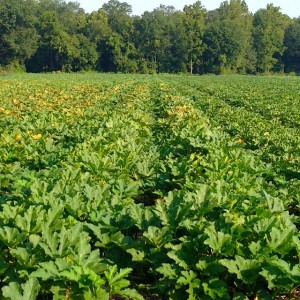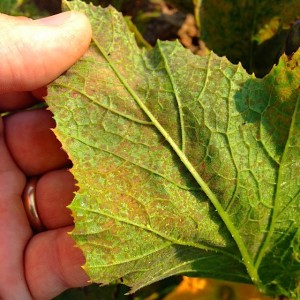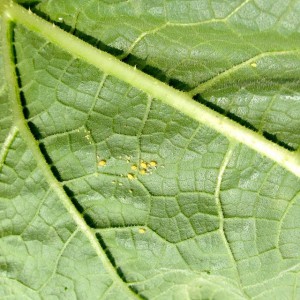Sweet Corn
European corn borer (ECB) adult activity has declined somewhat over the past week, with only scattered individuals outside of western Gloucester and Salem Counties (see ECB map). It remains to be seen whether we get another surge in moths as the summer winds down. As always, consider treating when the number of infested plants in a 50 plant sample exceeds 12%. Any planting remaining at or above threshold as it proceeds to full tassel should be treated, as this is the last stage at which ECB larvae will be exposed and vulnerable to insecticidal sprays.
See the 2015 Commercial Vegetable Recommendations Guide for insecticide choices.
| The highest nightly ECB catches for the previous week are as follows: | ||
| Allentown 1 | Folsom 1 | New Egypt 1 |
| Crosswicks 1 | Georgetown 1 | Pedricktown 1 |
| Downer 1 | Lawrenceville 1 | Tabernacle 1 |
| Farmingdale 1 | Medford 1 | Woodstown 1 |
Corn earworm moths (CEW) activity continues to increase gradually, with catches extending into the northern third of the state where catches of individual moths are more consistent. While activity is reasonably low for this time of year, sweet corn plantings in all areas are at risk from this population (see CEW Map). Trap catches to our south still offer no indication that there is an imminent, large-scale influx of moths headed for NJ at this time. As always, we will monitor our populations and report immediately should such an event occur.
| The highest nightly CEW blacklight trap catches for the previous week are as follows: | ||
| Beckett 3 | Medford 2 | Folsom 1 |
| Downer 2 | Springdale 2 | Pedricktown 1 |
| East Vineland 2 | Chester 1 | Tabernacle 1 |
| Green Creek 2 | Dayton 1 | Woodstown 1 |
The limited CEW pheromone trap network in the southern counties continues to show greater increases over the past week, with high catches in Cape May and coastal Salem counties. Overall activity is more consistent throughout the south, resulting in a broad area where a 3-4 day silk spray schedule (green area) is recommended (see CEW pheromone map). The somewhat more conservative scale of the pheromone map indicates a 2-day schedule (red areas) in coastal south Jersey, although this is not supported by blacklight trap catches in the same areas. 3-day schedules are warranted throughout southern NJ at this time.
| The highest nightly CEW pheromone trap catches for the previous week are as follows: | ||
| Green Creek 91 | Beckett 17 | Eldora 8 |
| East Vineland 25 | Springdale 15 | Pedricktown 3 |
| Woodstown 23 | Elm 10 | |
For silking sweet corn, the following spray schedules are warranted.
Silking Spray Schedules*:
South – 3 days
Central – 4 days
North – 5 days
There has been little change in fall armyworm (FAW) infestations continue throughout NJ, with double digit infestation rates throughout the state. This pest can be devastating to small corn plants. Fields down to seedling stage should be scouted weekly for signs of infestation. FAW do not respond well to pyrethroid insecticides. The most useful products are those in the IRAC group 28 class (Coragen, Exirel, Belt) or the IRAC group 5 class (Radiant, Entrust), or combination products including these classes. See the 2015 Commercial Vegetable Recommendations Guide for insecticides effective against FAW.
As nights get longer and dew periods lengthen, northern corn leaf blight (NCLB) has begun to appear in sweet corn plantings. This disease causes elongated gray lesions on older foliage (see photo). As the disease progresses, the lesions appear on younger leaves, and ultimately can impact the size and appearance of the ear. If this disease is discovered in whorl stage corn, it is likely that fungicide applications will be necessary to reduce the likelihood of yield loss. See the 2015 Commercial Vegetable Recommendations Guide for fungicides to manage NCLB.
Tomatoes
Some fields are heavily infested with cabbage looper (CL) (see photo of larva). This pest typically feeds on foliage (see photo of feeding), and causes little damage late in the season. There are several fields in northern NJ, however, where the field population is quite high, and larvae have begun to feed on green fruit. Foliar injury is extensive. CL is not likely to damage as many fruit as CEW can, but if fruit injury is discovered in association with heavy foliar feeding by CL, an insecticide application may be warranted.
Peppers
Pepper Weevil Report
No weevils have been trapped in the past week and as far as known, there are no infested fields.
Brown Marmorated Stink Bug (BMSB)
BMSB numbers remained very low in NJ blacklight traps this past week. These catches are too low to create a map. As yet, no fruit injury has been discovered in scouted pepper plantings.
Pumpkins and Winter Squash
Cucurbit downy mildew (CDM) is active on butternut squash, pumpkin and cucumber in NJ. As yet, acorn squash, watermelon and muskmelons are uninfected in the sentinel plot at the Snyder Research and Extension Farm in Hunterdon County. Some varieties are more susceptible to the strain of CDM that is present in NJ at this time (see photo 1). In this case, the more heavily infected variety is ‘Ironsides’, while the less affected variety to the right is ‘Little Giant’. Photo 2 shows the heavy sporulation found on the lower leaf surface of the heavily infected variety. For more information on the regional presence of DM as well as comprehensive, weekly forecasts, see the following website: http://cdm.ipmpipe.org/ Growers should consider applying both protectant and systemic fungicides to all cucurbit crops at this time, to limit loss from this disease as well as powdery mildew.
Additionally, melon aphid (see photo) has begun to appear in some fields. These aphids range in color from pale yellow to darker green, and can build to high numbers, especially if a pyrethroid insecticide is used on the field for management of another insect pest. Large populations on the foliage result in sticky droppings accumulating on the surface of the fruit. These droppings then serve as a substrate for sooty mold on which to grow. All of this caused the fruit to be unsightly and possibly needing to be cleaned prior to sale. If aphid populations reach the stage where colonies are appearing in multiple samples and stick droppings are obvious, consider an application of an insecticide that specifically targets this pest. Consult 2015 Commercial Vegetable Recommendations Guide for insecticides that target melon aphid on pumpkins.
